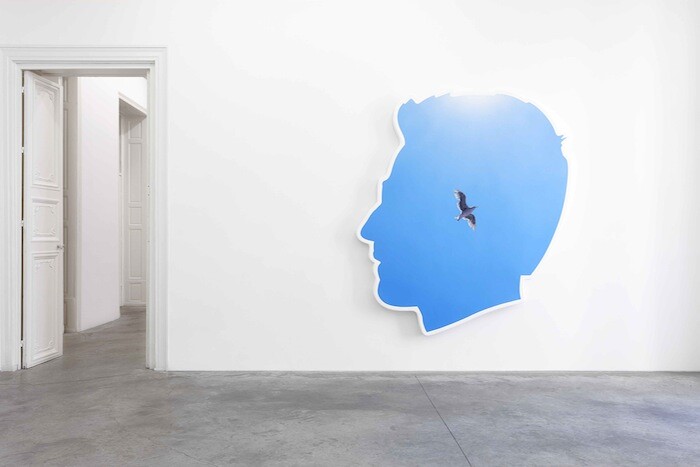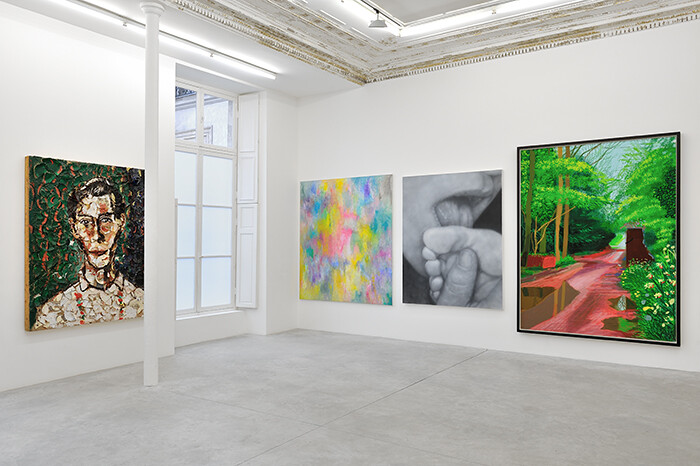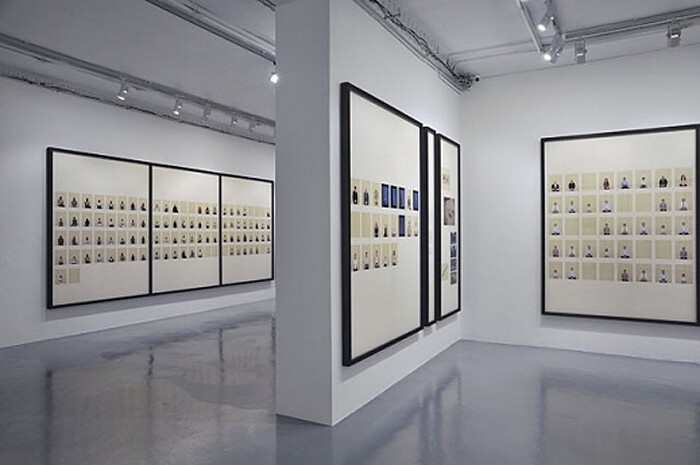Categories
Subjects
Authors
Artists
Venues
Locations
Calendar
Filter
Done
July 20, 2015 – Review
Alex Israel’s “Summer”
Mara Hoberman

“Summer,” Alex Israel’s second solo show with Almine Rech, imports the artist’s signature California cool vernacular—sunglasses, surfboards, convertibles—to an eighteenth-century mansion in Paris. Describing the physical, cultural, and industrial landscape of his hometown, the LA native’s recent paintings and sculptures are all about plastic, airbrushing, and plenty of sunshine.
In the gallery’s largest room, three eight-foot-tall sunglass lenses from Israel’s “Lens” series (2013–2015) lean nonchalantly against the walls. Translucent yellow, orange, and purple, these oversized plastic teardrops are unmistakably representational, but recall minimalist works by the Light and Space artists who pioneered the appropriation of industrial plastics for large-scale sculptures in LA in the 1960s. Evoking DeWain Valentine’s candy-colored polyester resin discs (a group of these “Circles” made in 1971 was shown in Paris for the first time at Almine Rech in 2014), Israel’s shiny convex surfaces revive the “fetish finish” aesthetic associated with Valentine and his contemporaries including Larry Bell and John McCracken. Elegantly bowed with beveled edges, the lenses glisten from the front and cast tinted halos onto the white walls behind them. Their sunset spectrum conjures the particularly Southern Californian combination of sun, sea, and smog that inspired the Light and Space artists half a century ago.
While paying …
January 28, 2015 – Review
“The Shell (Landscapes, Portraits & Shapes), a show by Éric Troncy”
Sabrina Tarasoff

In 1991, in response to critiques of his exhibition “No Man’s Time” at Villa Arson in Nice, curator Éric Troncy wrote a letter to the editors of Flash Art, in which he argued that the exhibition had been “based on no particular concept,” thus locating it outside of any theoretical framework. Instead, he positioned the show in proximity to Guy Debord’s idea of the spectacle, at least insofar as the viewer was presented with a spectacular kind of art—political, according to the curator, simply due to its negation of the heavily theoretical objectives and attitudes of galleries and institutions at the time. But in its apparent insurgency, Troncy’s radicalism seemed to belong solely to the leisure class, soliciting a conflation of art and life, which advocated a liberation from ideology, yet irrevocably gave way to a perverse commodification of the self.
Whilst it may seem uncalled for to hold Troncy to objectives declared over two decades ago, it is difficult to consider his recent exhibition at Almine Rech, “The Shell (Landscapes, Portaits & Shapes),” without being influenced by its resonances on the curator’s former conceptual approach. The exhibition, saturated with 42 paintings and a singular sculpture (a polyester caveman titled Giant, …
July 24, 2012 – Review
Taryn Simon’s "A Living Man Declared Dead and Other Chapters I–XVIII"
Arnaud Gerspacher

Repetition is never sameness. This is the first thought I had seeing Taryn Simon’s “A Living Man Declared Dead and Other Chapters I–XVIII” (2008–11). An aesthetics of taxonomy, each chapter in the work is comprised of identical framed panels of varying width showing three types of information under glass: 1) serialized and numbered portrait photographs grouped together neatly in rows; 2) documentary text and a registry of names referring back to the portraits; and 3) staggered documentary photographs, which serve as narrative supplementation for the portraits and the text. The presentation is polished, clean, and simple with little fuss—much cleaner than the stories they have to tell.
The work is the admirable result of research on a global scale, and each chapter documents sundry bloodlines and the circumstances surrounding their genealogy: a truncated family tree after the Bosnian genocide; the lineage of an official sent by the Zionist Organization to Palestine for settlement; a line up of mangled laboratory test rabbits not indigenous to Australia; the bloodlines of a family in the Druze religion based on strict inter-community reincarnation; a Kenyan doctor who gets paid in wives and cattle for his services; and the living-dead man himself, Shivdutt Yadav, whose status …